| |
Home
Farmer/Rancher Safety
Young Farm Worker Safety
Children's Safety
Media
|
So you’re looking to buy an approved equestrian helmet to wear every time you ride. You’re in luck. Thanks to advanced technology and the growing demand for equestrian helmets, there are many brands, styles and colours of approved* (see note below) riding headgear to choose from. The number one consideration when choosing your equestrian riding helmet is that it fits properly and feels comfortable. An improperly fitted helmet may not provide you with maximum protection and, if it’s too small, will probably create pressure points. After riding your horse for hours at a time, a helmet should feel like you just put it on.
To help you out in your search for a helmet, here are some tips to fit an equestrian riding helmet properly.
1. Measure the circumference of your head, placing the measuring tape about one inch above your eyebrows. Round your measurement to the nearest half-inch.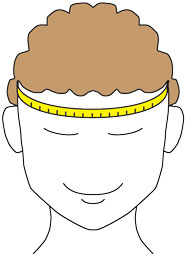
|
2. Match your measurement to the appropriate helmet size on the helmet size chart below. The sizing method will depend on the brand of helmet. The size range runs from size 6 for a 46 cm circumference to a size 7¾ for a 62 cm circumference.

3. Visit a tack shop to try on various helmets. Most shops that sell riding helmets have someone who can help you with fitting. Because riding helmets vary between brands and styles, it's best to visit a shop that stocks a few different models. Make sure any helmet you try on is ASTM/SEI or BSI certified. Place the helmet on your head, resting just above your eyebrows, with the visor level. Fasten the chin strap so it's close against your chin.
4. Move the helmet from side to side. It should fit comfortably snug all around your head. If there is room between your head and the helmet, you need a smaller size. If the helmet squeezes your head, causing pain or discomfort, you likely need a bigger size or a different style.
5. Observe your ears. The helmet should not press on your ears. If it does, adjust the suspension and padding inside the helmet so it then rests above the ears.
6. Check the helmet's brim. It should be no more than one inch above your eyebrows. If it is higher than that, it may not provide complete protection.
7. Bend over and hang your head. Shake your head up and down and from side to side. The helmet should not slide during these motions.
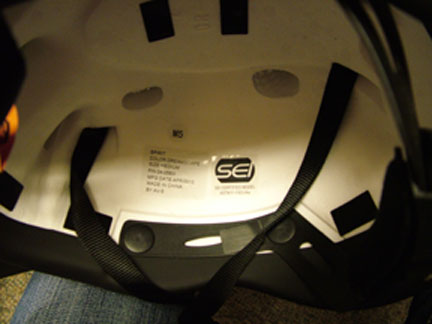 | Look for information labels on any approved helmet. In some cases they will be under a removable sweat-wicking liner. On this particular helmet, the label on the left includes the date the helmet was manufactured, while the label on the right is the SEI certification symbol. |
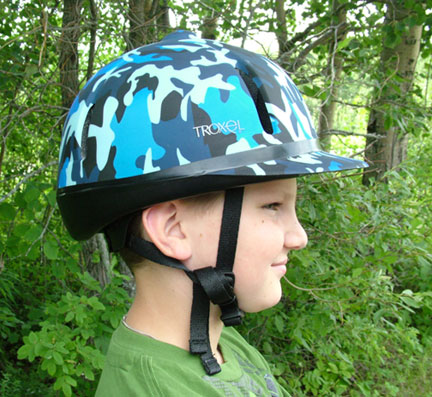 | This helmet fits correctly. The excess strap on the harness should be removed or secured once the helmet has been fitted correctly. |
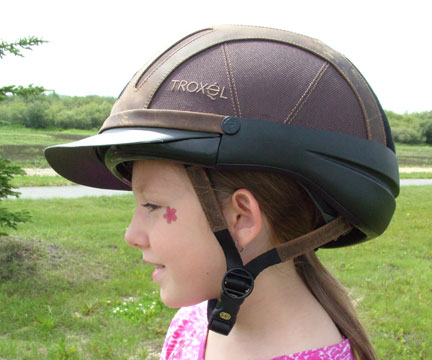 | This helmet is too big for this rider. It is tilted, the harness is too loose and there is too much room between the helmet and the rider’s head. |
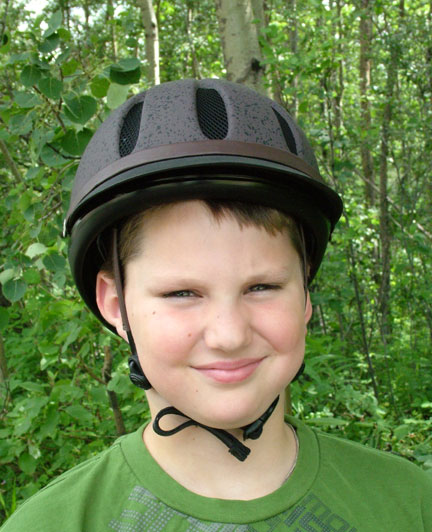 | This helmet is too small for this rider. It doesn’t cover enough of his head, is pinching above his ears and the harness is too tight. It won’t protect him properly, and most likely there are pressure points that will cause discomfort. |
With so many helmet options on the market, it’s important to pick a style and colour that you are happy with. Make your helmet part of your everyday riding and show apparel.
| In case you were wondering...
Your first equestrian helmet is just that - your first helmet. As long as you ride, plan to replace your helmet every three to five years, depending on amount of use, normal wear and tear and your intentions for riding. Some riders who compete have separate show helmets although this isn’t necessary. And of course, plan to replace your helmet if it takes any sort of significant impact.
*In Canada, protective headgear accepted by equine sport and other organizations must be certified under one of the following standard: ASTM (American Society for Testing Materials), or SEI (Safety Equipment Institute, Inc.); BSI/BS EN (British Standards Institution); EN (European Union Standards); or AS/NZS (Australian/New Zealand Standards). |
Equestrian helmet discussion
Safety Up on Equestrian Helmets factsheet
Alberta Farm Safety Program
Email: farm.safety@gov.ab.ca
or toll-free: 310-FARM (3276)
Alberta Agriculture and Forestry Farm Safety Staff:
Janice Donkers, Youth Coordinator: janice.donkers@gov.ab.ca
Kenda Lubeck, Awareness Coordinator: kenda.lubeck@gov.ab.ca
Raelyn Peterson, Coordinator: raelyn.d.peterson@gov.ab.ca
Sharon Stollery, Manager: sharon.stollery@gov.ab.ca
Blair Takahashi, Specialist: blair.takahashi@gov.ab.ca |
|